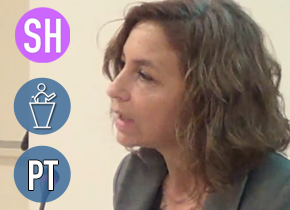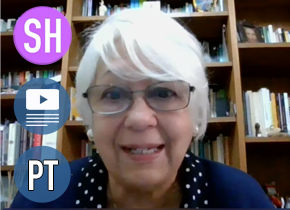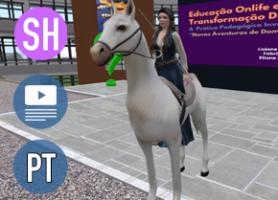Comparing NPS Users in Nightlife Settings and Online Communities.
Susana Henriques1,2; Joana Paula Silva1; Marie Claire Van Houtc3; Annemieke Benschop4; Dirk Korf5; Michal Bujalski6.
1) Center for Research and Studies in Sociology, University Institute of Lisbon (ISCTE-IUL), Portugal; 2) Universidade Aberta (UAb), Portugal; 3) School of Public and Allied Health, Liverpool John Moore’s University, Liverpool, United Kingdom; 4) Amsterdam University of Applied Sciences, Amsterdam, Netherlands; 5) Bonger Institute, University of Amsterdam, Amsterdam, Netherlands; 6) University of Warsaw, Institute of Applied Social Sciences, Warsaw, Poland.

CITE THIS VIDEO
Henriques, S. et al. (2023). Comparing nps users in nightlife settings and online communities. Video Journal of Social and Human Research, 3(1). 45-57. http/doi.org/10.18817/vjshr.v3i1.50
SYNOPSIS
This video reports on the comparison between two groups of New Psychoactive Substances (NPS) users: users in nightlife settings and users in online communities.
ABSTRACT
This article reports on the comparison between two groups of New Psychoactive Substances (NPS) users: users in nightlife settings and users in online communities. A quantitative survey was conducted in six EU countries (Germany, Hungary, Ireland, Netherlands, Poland, and Portugal) within a convenience sample of adult (18 years+) current (12-month) NPS users. Participants self-completed either a pen-and-paper or online questionnaire. 2,757 respondents across the six European countries were reached during data collection in the two considered user groups. The comparison was based on sociodemographic characteristics, use patterns and market. The groups of NPS used are: herbal blends and/or synthetic cannabinoids; branded stimulants and/or stimulants/empathogenics/nootropics obtained pure; psychedelics; dissociatives; and other NPS. Internet and virtual markets assume great relevance both for nightlife and online communities. Different drug policies and diverse geographical location between the participant countries are the main characteristics that impact on the results - namely in the presence/absence of some substances, or in the legal concept of NPS. Comparing users in nightlife settings and online users highlighted substantive trends in NPS use across countries and user groups. New opportunities in the drug market were driven by technological developments on the internet.
KEYWORDS
NPS; nightlife users; online users; categories of NPS; virtual markets; European trends.
REFERENCES
EMCDDA – European Monitoring Centre for Drugs and Addiction and Europol (2024). EU Drug Markets Analysis: Key insights for policy and practice. Publications Office of the European Union.
EMCDDA – European Monitoring Centre for Drugs and Addiction (2019). European Drug Report 2019: Trends and Developments. Publications Office of the European Union.
Gerostamoulos, D. & Di Rago M. (2023). Novel Psychoactive Substances. In Forensic and Legal Medicine, D. Gerostamoulos, M., Di Rago (eds). 9 pages. CRC Press. https://doi.org./10.1201/9781003138754
Felvinczi, K., Benschop, A., Urbán, R., Van Hout, M. C., Dąbrowska, K., Hearne, E., Henriques, S., Kaló, Z., Kamphausen, G., Silva, J. P., et al. (2019). Discriminative Characteristics of Marginalised Novel Psychoactive Users: a Transnational Study. International Journal of Mental Health and Addiction, 18(4), 1128–1147. https://doi.org/10.1007/s11469-019-00128-8
Korf, D., Benschop, A., Werse, B., Kamphausen, G., Felvinczi, K., Dąbrowska, K., Hernriques, S., Nabben, T., Wieczorek, Ł., Bujalski, M., et al. (2019). How and Where to Find NPS Users: a Comparison of Methods in a Cross-National Survey Among Three Groups of Current Users of New Psychoactive Substances in Europe. International Journal of Mental Health and Addiction, 19(4), 873–890. https://doi.org/10.1007/s11469-019-0052-8
Van Hout, M. C., Benschop, A., Bujalski, M., Dąbrowska, K., Demetrovics, Z., Felvinczi, K., Hearne, E., Henriques, S., Kaló, Z., Kamphausen, G., et al. (2018). Health and Social Problems Associated with Recent Novel Psychoactive Substance (NPS) Use Amongst Marginalised, Nightlife and Online Users in Six European Countries. International Journal of Mental Health and Addiction, 16(2), 480–495. https://doi.org/10.1007/s11469-017-9824-1
Van Hout, M. C., & Hearne, E. (2017). New psychoactive substances (NPS) on cryptomarket fora: An exploratory study of characteristics of forum activity between NPS buyers and vendors. International Journal of Drug Policy, 40, 102–110. https://doi.org/10.1016/j.drugpo.2016.11.007
Van Hout, M. C., & Hearne, E. (2016). User experiences of development of dependence on the synthetic cannabinoids, 5F-AKB48 and 5F-PB-22, and subsequent withdrawal syndromes. International Journal of Mental Health and Addiction, 15(3), 565–579. https://doi.org/10.1007/s11469-016-9650-x
Van Hout, M. C., & Bingham, T. (2013). ‘Silk Road’, the virtual drug marketplace: A single case study of user experiences. International Journal of Drug Policy, 24(5), 385–391. https://doi.org/10.1016/j.drugpo.2013.01.005
Werse, B., Benschop, A., Kamphausen, G., Van Hout, M. C., Henriques, S., Silva, J. P., Dąbrowska, K., Wieczorek, Ł., Bujalski, M., Felvinczi, K., et al. (2018). Sharing, Group-Buying, Social Supply, Offline and Online Dealers: how Users in a Sample from Six European Countries Procure New Psychoactive Substances (NPS). International Journal of Mental Health and Addiction, 17(5), 1237–1251. https://doi.org/10.1007/s11469-018-0043-1











